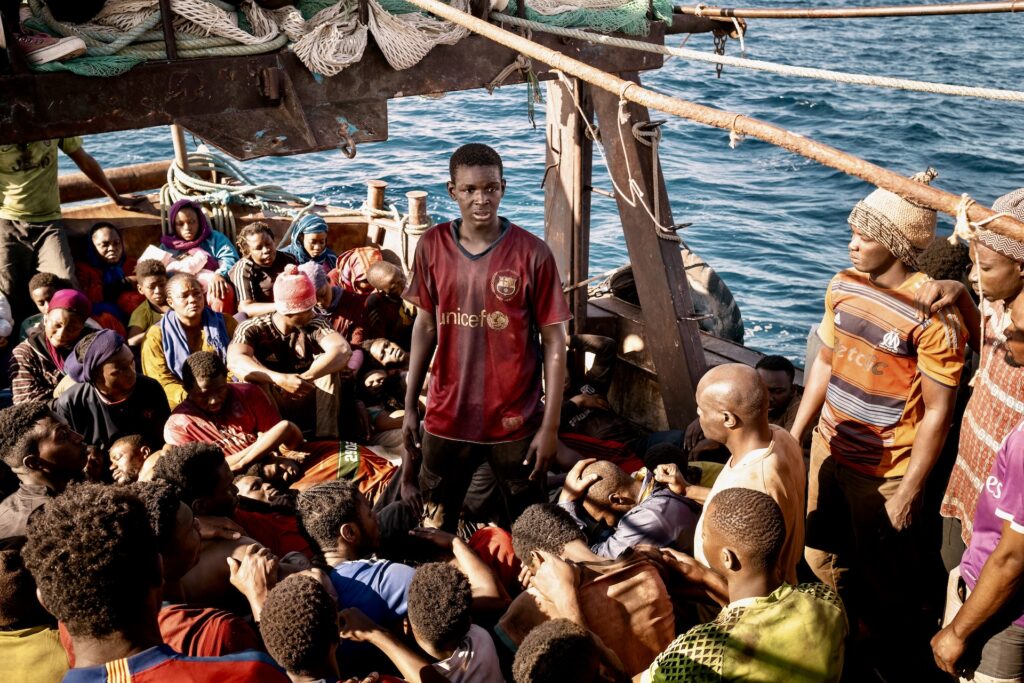
(****)
If you’ve ever wondered what an immigrant’s backstory might be, you ‘re not alone. It’s a subject worth exploring.
That’s why this sobering but illuminating parable by Italian writer/director Matteo Garrone (Gomorrah) is so compelling. He humanizes a journey thousands upon thousands of Sub-Sahara refugees make to the E.U. Doesn’t skip on the horrors, yet he lets his artistry color the narrative too. Like he’s showing the audience a storybook that charts a brutal passage, but with touches of magic. Garrone creates this fascinating concept aided by evocative colors, sets, props, clothes and photography as rendered by his talented crew: production designer (Dimitri Capuani), set decorators (Hind Ghazali and Roberta Troncarelli), costume designer (Stefano Ciammitti) and cinematographer (Paolo Carnera, Gomorrah).
Sixteen-year-old Seydou (Seydou Starr) lives a simple life in Dakar, Senegal, with his mother (Ndeye Khady Sy). He hangs out with his cousin Moussa (Moustapha Fall) as they contemplate their futures. Wanting more for his mother and himself, Seydou is talked into emigrating to the E.U. by Moussa, the assertive one. Seydou broaches the subject with mom: “I want to go to Europe to help out.” She’s insists: “Stay here and breathe the same air as me.” They have a home, clothes, food on the table and he goes to school. But his dreams are bigger than that. An older man, Sisko (Oumar Diaw), warns that the promised land is not heaven: “People are sleeping on the streets… thugs, criminals…”
Judiciously, the screenwriters (Garrone, Massimo Ceccherini, Massimo Gaudioso and Andrea Tagliaferri) make the lead character needy, but not dirt poor, sheltered and naïve. That makes this trip a bigger gamble. He could lose the little he has. Seydou could die. Traveling far will be a first-time experience as he follows Moussa’s lead. He’s in a vulnerable position.
The boys are conned by a smuggler with a picture of a fancy boat that will carry them to the E.U. They purchase fake Malian passports and follow an undisclosed trail others have taken. They journey through ancient lands, across dessert sands and over the Mediterranean Sea. Along the way they’re fleeced by border guards and bullied by human traffickers. Stranded, waylaid, imprisoned and pushed into adult situations they’re too young to understand.
Some directors would choose a cinema verité style for this undertaking. Ragged clothes, near colorless cinematography, raw language. Instead, Garrone chooses to make many frames as striking as a picture or a painting. The beauty of Africa, the majesty of its terrain, old dwellings and the mix of people from the cradle of civilization are on display as if they were in a museum or gallery.
There’s poignant dialogue, but often words come second and visual clues first. No character says their odyssey is life-threatening. You see it. One day the teens and other migrants are on the back of a pickup truck on a bumpy ride across hilly parched land. They’re jostled like they’re on a bucking bronco, not a vehicle. One poor soul falls to the ground. All are aghast, but the truck continues as if it has merely lost a package. In another scene, an unmarked path in the blazingly hot Sahara Desert is strewn with the corpses of other dreamers who didn’t survive. The travelers don’t comment. Facial expressions note they’re contemplating their fate.
Garrone also indulges in mystical imagery that shows feelings, despair, yearnings. When Seydou longs for his mother and wants to send a missive to her, an angel with straw wings delivers the message. When he tries to save a woman from dying in the dessert, he fails. It haunts him. In his subconscious, he walks on sands holding her hand while she floats in the air behind him, dressed in a green boubou (kaftan). Visions likes these might be distractions in a less skilled filmmaker’s hands. However, Garrone’s inventiveness is so consistently captivating, it creates a magical allure. A trance that lasts for 2h 1m (editor Marco Spoletini, Gomorrah).
When the producers and casting directors (Constance Demontoy, Iman Djionne, Amine Louadni and Francesco Vedovati) found the very natural and accessible lead actor Sarr they discovered a gem. As the young protagonist faces adversary after adversary and trauma after trauma, he further endears himself to all who watch. His three-dimensional persona and an empowering character arc help. An arc that makes a humble boy become an increasingly assertive young man. A leader who knows his strength. Io Capitano (English translation, I captain). Seydou: “I’ll take responsibility. I’ll get them to Italy, and no one will die.”
Moustapha Fall is equally engaging as his partner. They’re like brothers. In their most personal moments, when their friendship is tested, composer Andrea Farri’s music accentuates their emotions. In fact, all the supporting actors, from the shaman-like figures the boys meet along the way to the devils who bleed them, blend into the story seamlessly.
A migrant’s difficult tale and the stunning visuals work well together. On paper it sounds incongruent. On screen it’s poignant and indelible.
Trailer: https://www.youtube.com/watch?v=ajw425Kuvtw
Visit Film Critic Dwight Brown at DwightBrownInk.com.